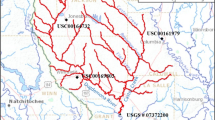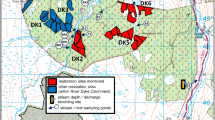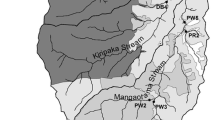Abstract
Many management strategies to improve the health of Chesapeake Bay focus on reducing losses of sediments and nutrients from agricultural land. Plot-scale studies have suggested that Best Management Practices (BMPs) reduce these losses, and natural resource managers have since supported implementation of a variety of BMPs on farms in the Chesapeake Bay watershed over the last two decades. As a test of the efficiency of these BMPs at the watershed scale, all farms within German Branch watershed had BMPs implemented in the early 1990s. Using water quality from two past monitoring programs (i.e., in 1986 and 1991–1995) and current water quality monitoring (i.e., collected 2003–2006), we detected a 28% decrease in baseflow P concentrations a decade after BMP implementation. There were no significant changes in nitrate or total nitrogen concentrations between BMP implementation and the most recent sampling. However, the significant rate of increase (∼0.08 mg N L−1 year−1) from 1986 to the 1990s did not continue to 2003–2006 baseflow conditions, which suggests that BMPs may have suppressed the rate of increase in nitrogen observed earlier in German. These data suggest that other management practices that increase agricultural N losses and natural processes that attenuate N losses at the watershed scale may obscure significant N reductions by current BMPs in the watershed.








Similar content being viewed by others
Abbreviations
- BMP:
-
Best Management Practice
- CBP:
-
Chesapeake Bay Program
- CREP:
-
Conservation Reserve Enhancement Program
- USDA:
-
United States Department of Agriculture
References
Beman, J. M., Arrigo, K. R., & Matson, P. A. (2005). Agricultural runoff fuels large phytoplankton blooms in vulnerable areas of the ocean. Nature, 434, 211–214. doi:10.1038/nature03370.
Bernhardt, E. S., Palmer, M. A., Allan, J. D., Alexander, G., Barnas, K., Brooks, S., et al. (2005). Synthesizing U.S. river restoration efforts. Science, 308, 636–637. doi:10.1126/science.1109769.
Boesch, D. F., Brinsfield, R. B., & Magnien, R. E. (2001). Chesapeake Bay eutrophication: scientific understanding, ecosystem restoration, and challenges for agriculture. Journal of Environmental Quality, 30, 303–320.
Bohlke, J. K., & Denver, J. M. (1995). Combined use of groundwater dating, chemical, and isotopic analyses to resolve the history and fate of nitrate contamination in two agricultural watersheds, Atlantic coastal plain, Maryland. Water Resources Bulletin, 31, 2319–2339.
Boyer, E. W., Goodale, C. L., Jaworski, N. A., & Howarth, R. W. (2002). Anthropogenic nitrogen sources and relationships to riverine nitrogen export in the northeastern USA. Biogeochemistry, 57/58, 137–169.
Butler, J. S., & Coale, F. J. (2005). Phosphorus leaching in manure-amended Atlantic Coastal Plain soils. Journal of Environmental Quality, 34, 370–381.
Carpenter, J. H., Pritchard, D. W., & Whaley, R. C. (1969). Observations of eutrophication and nutrient cycles in some coastal plain estuaries. In: Eutrophication: causes, consequences, correctives. Proceedings of the 1967 International Symposium on Eutrophication, University of Wisconsin (p. 210–221). Washington, DC: National Academy of Sciences.
Chesapeake Bay Commission (2004). Cost-effective strategies for the bay: Smart investments for nutrient and sediment reduction. Annapolis, MD: Chesapeake Bay Commission.
Chesapeake Bay Program (2000). Chesapeake bay agreement. Annapolis, MD: U.S. EPA.
Clark, A. J., Decker, A. M., Meisinger, J. J., & McIntosh, M. S. (1997). Kill date of vetch, rye, and a vetch-rye mixture. 1. Cover crop and corn nitrogen. Agronomy Journal, 89, 427–434.
Fisher, T. R., Hagy III, J. D., Boynton, W. R., & Williams, M. R. (2006). An analysis of cultural eutrophication in the Choptank and Patuxent River estuaries of Chesapeake Bay. Limnology and Oceanography, 51, 435–447.
Fisher, T. R., Lee, K.-Y., Berndt, G., Benitez, J. A., & Norton, M. M. (1998). Hydrology and chemistry of the Choptank River Basin. Water, Air, and Soil Pollution, 105, 387–397.
Jordan, T. E., Correll, D. L., & Weller, D. E. (1997). Effects of agriculture on discharges of nutrients from coastal plain watersheds of Chesapeake Bay. Journal of Environmental Quality, 26, 836–848.
Jordan, T. E., & Weller, D. E. (1996). Human contributions to terrestrial nitrogen flux. BioScience, 46, 655–663.
Kemp, W. M., Boynton, W. R., Adolf, J. E., Boesch, D. F., Boicourt, W. C., Brush, G., et al. (2005). Eutrophication of Chesapeake Bay: historical trends and ecological interactions. Marine Ecological Progress Series, 303, 1–29.
Lee, K.-Y., Fisher, T. R., Jordan, T. E., Correll, D. L., & Weller, D. E. (2000). Modeling the hydrochemistry of the Choptank River Basin using GWLF and Arc/Info: 1. Model calibration and validation. Biogeochemistry, 49, 143–173.
Lee, K.-Y., Fisher, T. R., & Rochelle-Newall, E. (2001). Modeling the hydrochemistry of the Choptank River Basin using GWLF and Arc/Info: 2. Model application. Biogeochemistry, 56, 311–348.
Lowrance, R., Altier, L. S., Newbold, J. D., Schnabel, R. R., Goffman, P. M., Denver, J. M., et al. (1997). Water quality functions of riparian forest buffers in Chesapeake Bay watersheds. Environmental Management, 21, 687–712.
Magnien, R., Boward, D., & Bieber, S. (Eds.). (1995). The state of the Chesapeake 1995. Annapolis, MD: U.S. EPA.
Meisinger, J. J., & Randall, G. W. (1991). Estimating nitrogen budgets for soil-crop systems. In R. F. Follett, D. R. Keeney, & R. M. Cruse (Eds.), Managing nitrogen for groundwater quality and farm profitability. Madison, WI: SSSA.
Norton, M. M., & Fisher, T. R. (2000). The effects of forest on stream water quality in two coastal plain watersheds of the Chesapeake Bay. Ecological Engineering, 14, 337–362.
Officer, C. B., Biggs, R. B., Taft, J. L., Cronin, E., Tyler, M. A., & Boynton, W. R. (1984). Chesapeake Bay anoxia: origin, development, and significance. Science, 223, 22–27.
Orth, R. J., & Moore, K. A. (1983). Chesapeake Bay: an unprecedented decline in submerged aquatic vegetation. Science, 222, 51–53.
Peierls, B. L., Caraco, N. F., Pace, M. L., & Cole, J. J. (1991). Human influence on river nitrogen. Nature, 350, 386–387.
Phillips, P. J., Denver, J. M., Shedlock, R. J., & Hamilton, P. A. (1993). Effect of forested wetlands on nitrate concentrations in ground water and surface water on the Delmarva Peninsula. Wetlands, 13, 75–83.
Primrose, N. L., Millard, C. J., McCoy, J. L., Sturm, P. E., Dobson, M. G., & Bowen, S. E. (1997). German branch targeted watershed project: Report on 5 years of biotic and water quality monitoring 1990 through 1995. Annapolis, MD: Chesapeake and Coastal Watershed Service, Watershed Restoration Division, Maryland Department of Natural Resources.
Seliger, H. H., Boggs, J. A., & Biggley, W. H. (1985). Catastrophic anoxia in the Chesapeake Bay in 1984. Science, 228, 70–73.
Sims, J. T., Simard, R. R., & Joern, B. C. (1998). Phosphorus loss in agricultural drainage: historical perspective and current research. Journal of Environmental Quality, 27, 277–293.
Staver, K. W. (2001a). Increasing N retention in coastal plain agricultural watersheds. In R. F. Follett, D. R. Keeney, & R. M. Cruse (Eds.), Managing nitrogen for groundwater quality and farm profitability (pp. 85–124). Madison, WI: Soil Science Society of America.
Staver, K. W. (2001b). The effect of agricultural best management practices on subsurface nitrogen transport in the German Branch watershed. Final Rep. MD Dept. Nat. Res. Proj. 14-198-34CZM025
Staver, K. W., & Brinsfield, R. B. (1994). The effect of erosion control practices on phosphorus transport from coastal plain agricultural watersheds. Chesapeake Research Consortium Publication, 149, 215–222.
Staver, K. W., & Brinsfield, R. B. (1998). Using cereal grain winter cover crops to reduce groundwater nitrate contamination in the Mid-Atlantic coastal plain. Journal of Soil and Water Conservation, 53, 230–240.
Staver, K. W., & Brinsfield, R. B. (2001). Agriculture and water quality on the Maryland eastern shore: where to we go from here? Bioscience, 51, 859–868.
Sutton, A. J. (2006). Evaluation of agricultural nutrient reductions in restored riparian buffers. University of Maryland Dissertation.
United States Department of Agriculture (1996). German branch water quality hydrologic unit area Queen Anne’s County, Maryland: FY96 annual report. Washington, D.C.: USDA.
United States Department of Agriculture (2004). Maryland conservation reserve enhancement program draft: Programmatic environmental assessment. Washington, D.C.: USDA, Farm Services Agency.
Valderrama, J. C. (1981). The simultaneous analysis of total nitrogen and total phosphorus in natural waters. Marine Chemistry, 10, 109–122.
Vitousek, P. M., Aber, J. D., Howarth, R. W., Likens, G. E., Matson, P. A., Schindler, D. W., et al. (1997). Human alteration of the global nitrogen cycle: sources and consequences. Ecological Applications, 7, 737–750.
Acknowledgements
This project was funded by the US Department of Agriculture (Cooperative Agreement 58-1265-5-041) and the Agricultural Research Service. We thank Tom Jordan for access to water quality data collected during the Targeted Watershed Project and Ken Staver for sharing his calculations of groundwater retention time in German Branch watershed. We also thank the agricultural extension agents and managers at local Farm Service Agency and Natural Resources Conservation Service offices for their local knowledge and insights.
Author information
Authors and Affiliations
Corresponding author
Rights and permissions
About this article
Cite this article
Sutton, A.J., Fisher, T.R. & Gustafson, A.B. Historical Changes in Water Quality at German Branch in the Choptank River Basin. Water Air Soil Pollut 199, 353–369 (2009). https://doi.org/10.1007/s11270-008-9884-8
Received:
Accepted:
Published:
Issue Date:
DOI: https://doi.org/10.1007/s11270-008-9884-8




